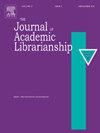高校图书馆选址对职业效率的影响——以高校校园设计为例
IF 2.3
3区 管理学
Q2 INFORMATION SCIENCE & LIBRARY SCIENCE
引用次数: 0
摘要
大学校园的布局作为教育和学习的场所有着重要而持续的遗产。学术图书馆的位置通常反映了它与大学校园的相关性。了解空间因素也有助于将图书馆安排在用户满意的最佳位置。本研究考察了教育校园建筑的空间配置,以确定图书馆的位置如何影响职业效率,并研究了展示优秀图书馆位置的大学校园的最佳建筑规划特征。检验采用混合方法分析,利用定性和定量方法。定性数据通过绘图收集,定量数据使用Depthmap X10中的轴向和VGA图来测量空间和视觉特征。结果表明,空间和视觉的连通性以及突出的选择影响着校园设计。一项研究得出结论,无论一个优秀的Isovist区域,校园规划布局都需要强大的网络路径来导航。该研究有助于整合步行规划网络,大规模功能分布和集中化,以实现最佳使用。本文章由计算机程序翻译,如有差异,请以英文原文为准。
The impact of academic library location on occupational efficiency: A comparison of the university's campus design
The university campus layout has a significant and continuous legacy as a place for education and learning. The academic library's location usually reflects its relevance to the university's campus. Understanding spatial factors can also help arrange academic libraries with the best locations for user satisfaction. This study examines the spatial configurations of educational campus buildings to determine how the library's location affects occupational efficiency and investigates the optimal architectural planning characteristics of university campuses that demonstrate outstanding library locations. The inspection employed mixed-methods analysis, utilizing both qualitative and quantitative approaches. Qualitative data were collected through drawings, while quantitative data were gathered using Axial and VGA maps in Depthmap X10 to measure spatial and visual characteristics. The results show that spatial and visual connectivity, as well as prominent choices, influence campus design. A study concludes that, regardless of an excellent Isovist area, campus planning layouts require strong network paths for navigation. The study contributes to integrating the pedestrian planning network, mass functional distribution, and centralization for optimal use.
求助全文
通过发布文献求助,成功后即可免费获取论文全文。
去求助
来源期刊

Journal of Academic Librarianship
INFORMATION SCIENCE & LIBRARY SCIENCE-
CiteScore
5.30
自引率
15.40%
发文量
120
审稿时长
29 days
期刊介绍:
The Journal of Academic Librarianship, an international and refereed journal, publishes articles that focus on problems and issues germane to college and university libraries. JAL provides a forum for authors to present research findings and, where applicable, their practical applications and significance; analyze policies, practices, issues, and trends; speculate about the future of academic librarianship; present analytical bibliographic essays and philosophical treatises. JAL also brings to the attention of its readers information about hundreds of new and recently published books in library and information science, management, scholarly communication, and higher education. JAL, in addition, covers management and discipline-based software and information policy developments.
 求助内容:
求助内容: 应助结果提醒方式:
应助结果提醒方式:


